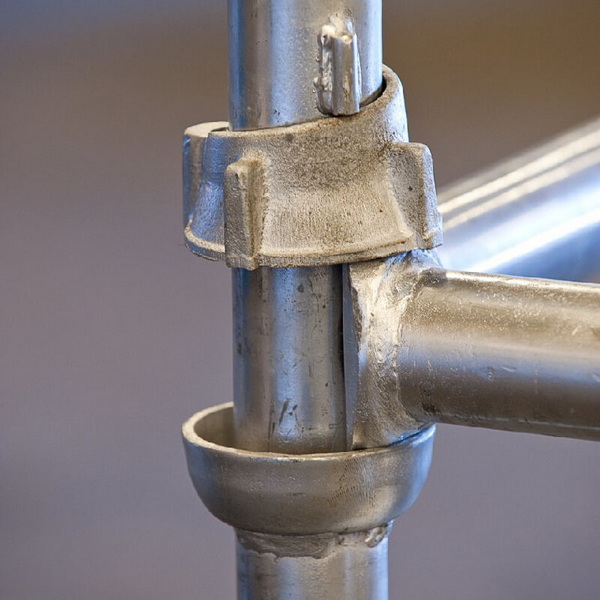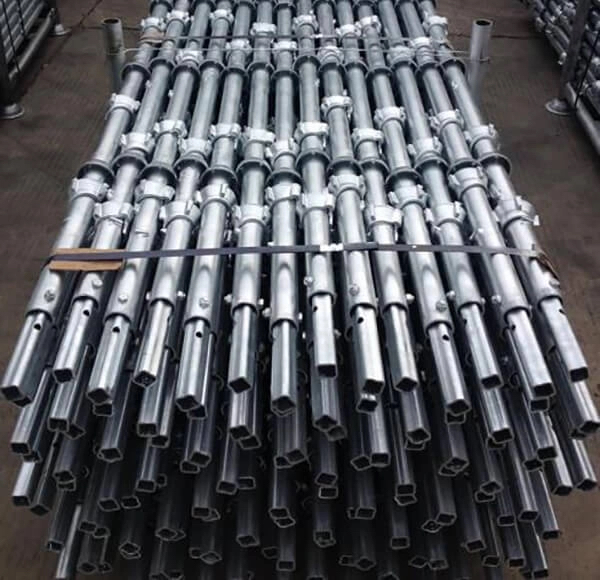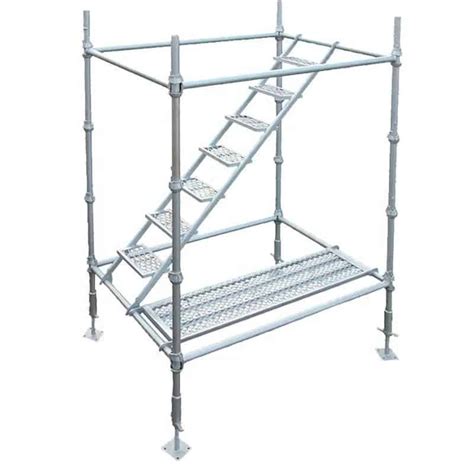Content Menu
● Key Features of Cuplock Scaffolding
● Types of Cuplock Scaffolding
>> 1. Standard Cuplock Scaffolding
>> 2. Heavy-Duty Cuplock Scaffolding
>> 3. Cantilever Cuplock Scaffolding
>> 4. Facade Cuplock Scaffolding
>> 5. Shoring Cuplock Scaffolding
● Advantages of Cuplock Scaffolding
● Applications of Cuplock Scaffolding
● Safety Considerations
● Maintenance and Storage
● Environmental Impact
● Future Developments
● Case Studies
>> Example 1: Bridge Construction
>> Example 2: High-Rise Building
>> Example 3: Industrial Maintenance
● Regulations and Standards
● Comparison with Other Scaffolding Systems
● Economic Benefits
● Technological Integration
● Global Market Trends
● Conclusion
● FAQ
>> 1. What is the main advantage of using Cuplock scaffolding?
>> 2. How does the locking mechanism work?
>> 3. What materials are used in Cuplock scaffolding?
>> 4. Can Cuplock scaffolding be used for curved structures?
>> 5. Is Cuplock scaffolding suitable for heavy-duty applications?
● Citations:
Cuplock scaffolding is a modular scaffolding system widely used in construction for its versatility, efficiency, and safety. It features a unique locking mechanism that connects horizontal and vertical components using metal cups, ensuring secure joints and excellent stability. This system is ideal for projects requiring frequent adjustments or complex architectural configurations.

Key Features of Cuplock Scaffolding
1. Modular Design:
- Cuplock scaffolding is composed of pre-engineered components such as standards, ledgers, and braces.
- Its modularity allows for quick assembly and disassembly.
2. Unique Locking Mechanism:
- The system uses a circular cup-node locking device.
- A single vertical standard can connect up to four horizontal ledgers at one node point.
3. High Load-Bearing Capacity:
- Made from high-tensile steel, the system can support heavy loads.
- Suitable for shoring applications in large-scale infrastructure projects.
4. Ease of Use:
- Requires minimal tools (usually just a hammer) for assembly.
- Reduces labor costs and time on-site.
Types of Cuplock Scaffolding
1. Standard Cuplock Scaffolding
- Used for general construction projects.
- Composed of vertical standards and horizontal ledgers.
- Provides a stable platform for workers and materials.
2. Heavy-Duty Cuplock Scaffolding
- Designed for high-load applications like shoring and formwork support.
- Commonly used in bridges and large-scale infrastructure.
3. Cantilever Cuplock Scaffolding
- Extends beyond the main scaffold structure.
- Useful for accessing hard-to-reach areas or bypassing obstructions.
4. Facade Cuplock Scaffolding
- Specifically designed for tasks like facade painting, cleaning, or material installation.
- Provides extended platforms for easy access to building exteriors.
5. Shoring Cuplock Scaffolding
- Supports formwork during concrete setting.
- Ensures stability in high-load scenarios such as bridge construction.
Advantages of Cuplock Scaffolding
1. Time-Saving: Quick assembly with fewer components compared to traditional scaffolding systems.
2. Cost-Effective: Reduces labor costs due to its simplicity and modularity.
3. Versatility: Can be adapted to various project requirements, including curved structures and stair towers.
4. Enhanced Safety: Features like guardrails, ladder safety gates, and continuous platforms ensure worker safety.
Applications of Cuplock Scaffolding
- Residential and commercial building construction.
- Infrastructure projects like bridges and tunnels.
- Maintenance tasks on industrial facilities.
- Shipbuilding and renovation projects.

Safety Considerations
Ensuring safety is paramount when using Cuplock scaffolding. Here are some key considerations:
1. Regular Inspections: Regularly inspect scaffolding for damage or wear.
2. Proper Training: Ensure workers are trained in assembly and disassembly procedures.
3. Load Limits: Never exceed the recommended load capacity.
4. Weather Conditions: Secure scaffolding against wind and rain.
Maintenance and Storage
To extend the lifespan of Cuplock scaffolding, proper maintenance and storage are essential:
1. Cleaning: Regularly clean components to prevent rust.
2. Storage: Store components in dry conditions to prevent corrosion.
3. Inspection: Regularly inspect for damage and replace worn parts.
Environmental Impact
Cuplock scaffolding is generally environmentally friendly due to its reusability and durability. However, ensuring that materials are sourced sustainably and that waste is minimized during construction can further reduce its environmental footprint.
Future Developments
As technology advances, we can expect to see innovations in Cuplock scaffolding, such as lighter materials or more efficient assembly systems. These developments will likely enhance its versatility and reduce environmental impact even further.
Case Studies
Example 1: Bridge Construction
Cuplock scaffolding was used in a major bridge project to support formwork during concrete pouring. Its high load-bearing capacity and stability ensured the success of the project.
Example 2: High-Rise Building
In a high-rise construction project, Cuplock scaffolding provided a flexible and safe platform for workers to perform exterior finishing tasks efficiently.
Example 3: Industrial Maintenance
Cuplock scaffolding was used for maintenance tasks in an industrial facility, allowing workers to access hard-to-reach areas safely and efficiently.
Regulations and Standards
Cuplock scaffolding must comply with various safety standards and regulations, such as OSHA guidelines in the U.S. or EN 12811 in Europe. Ensuring compliance is crucial for maintaining a safe working environment.
Comparison with Other Scaffolding Systems
Cuplock scaffolding is often compared to other systems like tube and clamp or frame scaffolding. While each has its advantages, Cuplock stands out for its ease of assembly and versatility.
Economic Benefits
The economic benefits of Cuplock scaffolding are significant. It reduces labor costs through quick assembly and minimizes material waste due to its modular design. Additionally, its durability extends its lifespan, reducing the need for frequent replacements.
Technological Integration
In recent years, Cuplock scaffolding has seen integration with advanced technologies such as digital monitoring systems. These systems can track scaffold stability and load capacity in real-time, enhancing safety and efficiency.
Global Market Trends
The global demand for Cuplock scaffolding is increasing due to its versatility and efficiency. As construction projects become more complex, the need for adaptable scaffolding systems like Cuplock continues to grow.
Conclusion
Cuplock scaffolding stands out as an efficient, versatile, and safe solution for modern construction needs. Its modular design, unique locking mechanism, and adaptability make it indispensable across various industries, from residential buildings to large-scale infrastructure projects.

FAQ
1. What is the main advantage of using Cuplock scaffolding?
Cuplock scaffolding offers quick assembly, high stability, and versatility, making it ideal for various construction applications.
2. How does the locking mechanism work?
The locking mechanism uses a circular node point where up to four horizontal ledgers can connect to a vertical standard with a single hammer blow.
3. What materials are used in Cuplock scaffolding?
It is typically made from high-tensile steel, ensuring durability and high load-bearing capacity.
4. Can Cuplock scaffolding be used for curved structures?
Yes, its flexible design allows it to adapt to curved or irregular architectural shapes.
5. Is Cuplock scaffolding suitable for heavy-duty applications?
Absolutely! Heavy-duty variants are specifically designed for tasks like shoring and formwork support in large-scale projects.
Citations:
[1] https://constrofacilitator.com/the-versatility-of-cuplock-scaffolding-systems-in-modern-construction/
[2] https://jumplyscaffolding.com/what-is-cuplock-scaffolding/
[3] https://www.wm-scaffold.com/cup-lock-scaffold.html
[4] https://www.linkedin.com/pulse/cuplock-system-decking-infill-advantages-origin-abhishek-mishra
[5] https://www.sparsteel.com/blog/cuplock-scaffolding-types-uses-and-benefits/
[6] https://www.internationalscaffolding.com/projects/what-is-a-cuplock-scaffolding-system/
[7] https://www.avontus.com/scaffolding-encyclopedia/twelve-common-types-of-scaffolding-in-construction/
[8] https://assets.website-files.com/66f42abc97ec5a674ec026bc/66fa2698689716374a110aee_36019422232.pdf






















